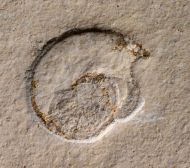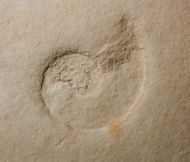Fossils for sale
Ammonites

Ammonites from the Solnhofen Limestone
Ammonites from the Solnhofen Limestone are not only important index fossils, but also a fascinating field of research. They document the biostratigraphy of the Upper Jurassic, show remarkable species diversity, and raise questions about preservation that remain unresolved to this day.
Ammonite Zones of the Lithographic Limestones
The Solnhofen limestones belong to the Tithonian stage of the Upper Jurassic. Biostratigraphically, this interval is characterized by the index ammonite Hybonoticeras hybonotum. This species serves as a marker for the so‑called Hybonotum Zone, which allows precise stratigraphic classification. Thus, ammonites are not only collector’s items but also keys to geological time determination. Within this main zone of the Solnhofen Formation, the deposits are often subdivided into ammonite subzones, which may vary regionally (e.g. between the lagoons of the Solnhofen archipelago such as the Eichstätt and Solnhofen basins).
| Stratigraphic Unit | Age (Upper Jurassic, Tithonian) | Index Ammonites / Subzones | Typical Localities | Remarks |
|---|---|---|---|---|
| Mörnsheim Beds | ca. 145.5–146 Ma | upper part of the Hybonoticeras hybonotum Zone | Mörnsheim, Wintershof | Younger than the classic lithographic limestones; fine‑grained limestones; lower fossil diversity; important transitional beds |
| Classic Solnhofen Limestones | ca. 146–147 Ma | Hybonoticeras hybonotum Zone; subzones: Subplanites rueppelianus, Lingulaticeras solenoides, locally Neochetoceras mucronatum | Solnhofen, Eichstätt, Langenaltheim, Blumenberg | Famous for exceptional preservation (e.g. Archaeopteryx, crustaceans, fishes, ammonites); reference window of the Lagerstätte |
| Zandt / Brunn / Ried (lower limestones) | ca. 147–148 Ma | lower parts of the Hybonoticeras hybonotum Zone (frequent Neochetoceras, Suplanites) | Zandt, Brunn, Ried | Older lithographic limestones; mostly small ammonites; taphonomically less spectacular but important for fine stratigraphy and species diversity |
| Treuchtlingen Marble | Kimmeridgian, approx. 149 Ma | Aulacostephanus, Hibolithes | Treuchtlingen (Altmühltal) | Very fine‑grained, massive limestone; economically important building stone; fossils (ammonites, belemnites) known, but preserved with less detail |
| Wattendorf / Torleite Formation (underlying) | older than 148 Ma (late Kimmeridgian) | transition to other ammonite zones (e.g. Hybonoticeras beckeri, regional) | Wattendorf | Marls and limestones; no classic lithographic limestones; stratigraphic basement of the Solnhofen Formation |
Soft‑tissue Preservation – an Unresolved Puzzle
The Solnhofen limestones are renowned for their exceptional preservation, which even includes soft tissues of crustaceans, fishes, and squids. In ammonites, however, soft‑tissue remains are extremely rare.
Possible explanations include floating shells: after death, ammonite shells may have drifted at the water surface for a long time. By the time they sank, the soft parts had already decayed or were lost. Yet there are ammonites with clear bite marks in the body chamber. These shells must have sunk more quickly, but they also show no soft‑tissue preservation.


